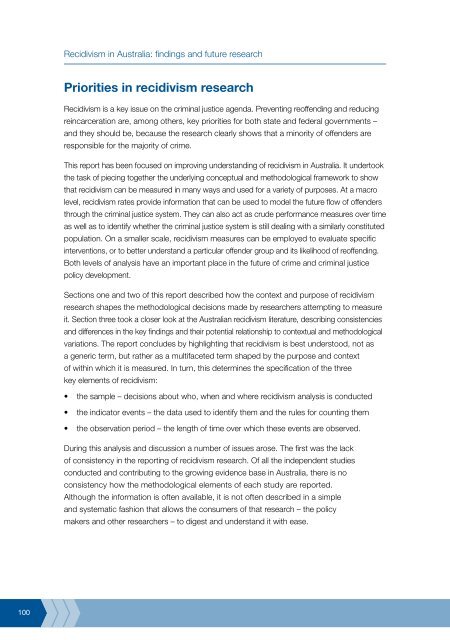Recidivism in Australia : findings and future research - Australian ...
Recidivism in Australia : findings and future research - Australian ...
Recidivism in Australia : findings and future research - Australian ...
Create successful ePaper yourself
Turn your PDF publications into a flip-book with our unique Google optimized e-Paper software.
100<br />
<strong>Recidivism</strong> <strong>in</strong> <strong>Australia</strong>: f<strong>in</strong>d<strong>in</strong>gs <strong>and</strong> <strong>future</strong> <strong>research</strong><br />
Priorities <strong>in</strong> recidivism <strong>research</strong><br />
<strong>Recidivism</strong> is a key issue on the crim<strong>in</strong>al justice agenda. Prevent<strong>in</strong>g reoffend<strong>in</strong>g <strong>and</strong> reduc<strong>in</strong>g<br />
re<strong>in</strong>carceration are, among others, key priorities for both state <strong>and</strong> federal governments –<br />
<strong>and</strong> they should be, because the <strong>research</strong> clearly shows that a m<strong>in</strong>ority of offenders are<br />
responsible for the majority of crime.<br />
This report has been focused on improv<strong>in</strong>g underst<strong>and</strong><strong>in</strong>g of recidivism <strong>in</strong> <strong>Australia</strong>. It undertook<br />
the task of piec<strong>in</strong>g together the underly<strong>in</strong>g conceptual <strong>and</strong> methodological framework to show<br />
that recidivism can be measured <strong>in</strong> many ways <strong>and</strong> used for a variety of purposes. At a macro<br />
level, recidivism rates provide <strong>in</strong>formation that can be used to model the <strong>future</strong> flow of offenders<br />
through the crim<strong>in</strong>al justice system. They can also act as crude performance measures over time<br />
as well as to identify whether the crim<strong>in</strong>al justice system is still deal<strong>in</strong>g with a similarly constituted<br />
population. On a smaller scale, recidivism measures can be employed to evaluate specific<br />
<strong>in</strong>terventions, or to better underst<strong>and</strong> a particular offender group <strong>and</strong> its likelihood of reoffend<strong>in</strong>g.<br />
Both levels of analysis have an important place <strong>in</strong> the <strong>future</strong> of crime <strong>and</strong> crim<strong>in</strong>al justice<br />
policy development.<br />
Sections one <strong>and</strong> two of this report described how the context <strong>and</strong> purpose of recidivism<br />
<strong>research</strong> shapes the methodological decisions made by <strong>research</strong>ers attempt<strong>in</strong>g to measure<br />
it. Section three took a closer look at the <strong>Australia</strong>n recidivism literature, describ<strong>in</strong>g consistencies<br />
<strong>and</strong> differences <strong>in</strong> the key f<strong>in</strong>d<strong>in</strong>gs <strong>and</strong> their potential relationship to contextual <strong>and</strong> methodological<br />
variations. The report concludes by highlight<strong>in</strong>g that recidivism is best understood, not as<br />
a generic term, but rather as a multifaceted term shaped by the purpose <strong>and</strong> context<br />
of with<strong>in</strong> which it is measured. In turn, this determ<strong>in</strong>es the specification of the three<br />
key elements of recidivism:<br />
•<br />
•<br />
•<br />
the sample – decisions about who, when <strong>and</strong> where recidivism analysis is conducted<br />
the <strong>in</strong>dicator events – the data used to identify them <strong>and</strong> the rules for count<strong>in</strong>g them<br />
the observation period – the length of time over which these events are observed.<br />
Dur<strong>in</strong>g this analysis <strong>and</strong> discussion a number of issues arose. The first was the lack<br />
of consistency <strong>in</strong> the report<strong>in</strong>g of recidivism <strong>research</strong>. Of all the <strong>in</strong>dependent studies<br />
conducted <strong>and</strong> contribut<strong>in</strong>g to the grow<strong>in</strong>g evidence base <strong>in</strong> <strong>Australia</strong>, there is no<br />
consistency how the methodological elements of each study are reported.<br />
Although the <strong>in</strong>formation is often available, it is not often described <strong>in</strong> a simple<br />
<strong>and</strong> systematic fashion that allows the consumers of that <strong>research</strong> – the policy<br />
makers <strong>and</strong> other <strong>research</strong>ers – to digest <strong>and</strong> underst<strong>and</strong> it with ease.















